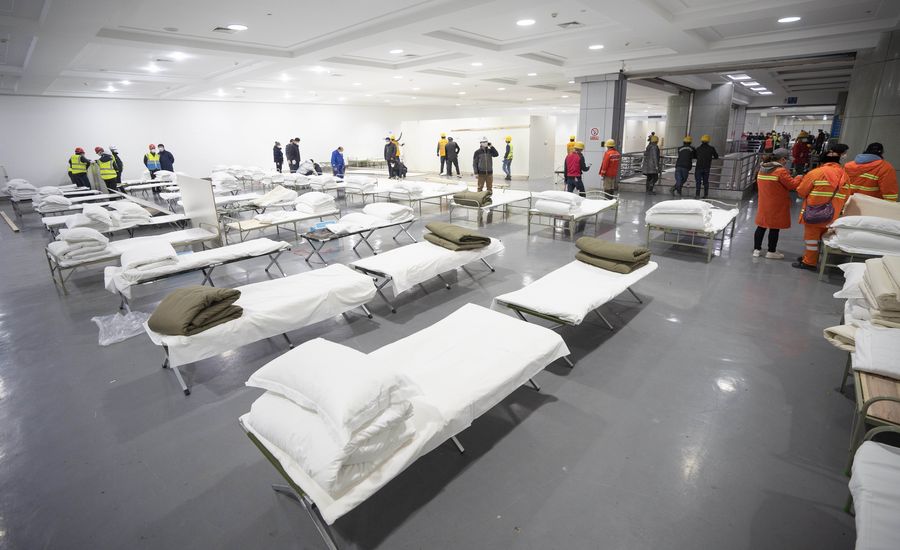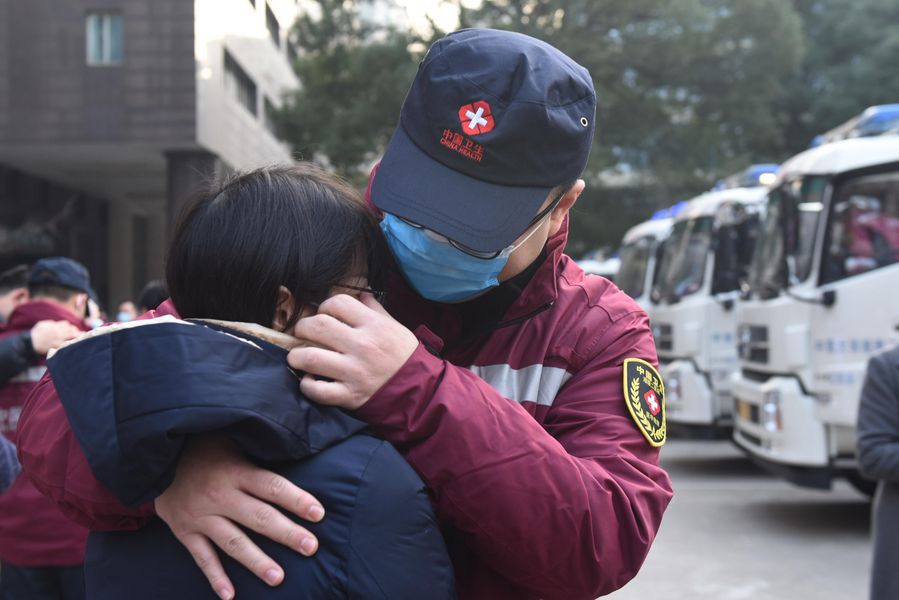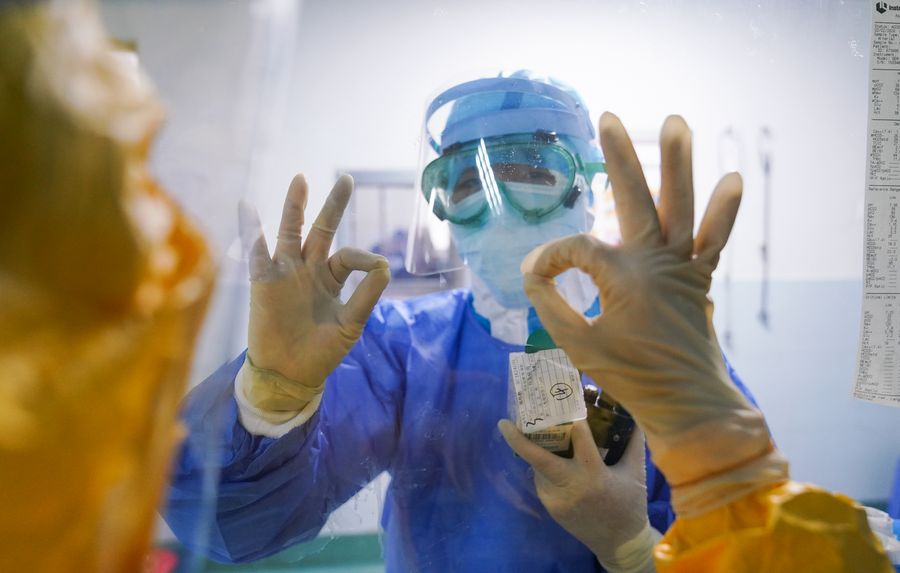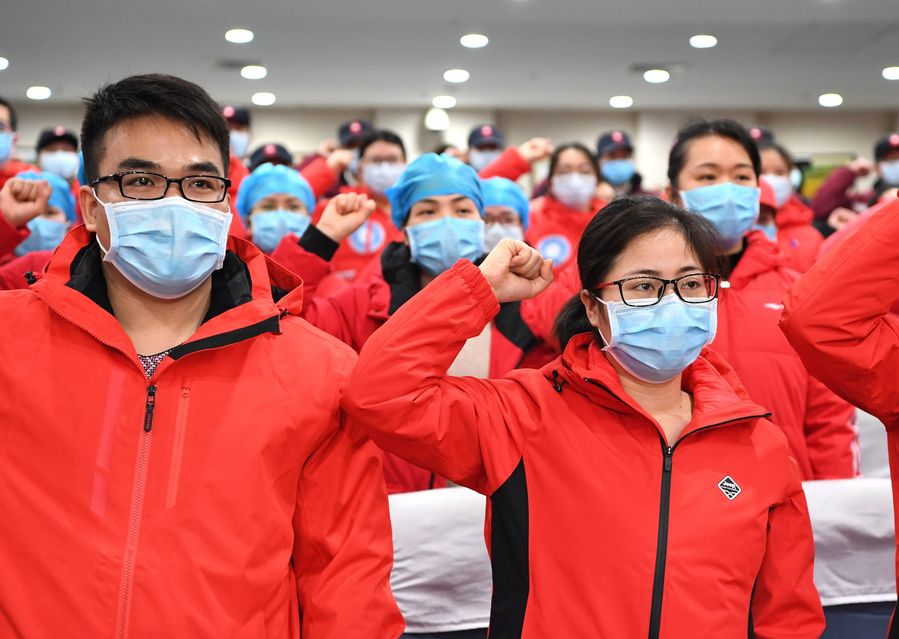
Workers are busy converting Wuhan International Conference and Exhibition Center into temporary hospital in Wuhan, central China's Hubei Province, Feb. 4, 2020. (Xinhua/Cai Yang)
To contain the spread of the coronavirus within the shortest time possible, China has exhorted all sectors to push the prevention and control work into full swing. The most strict measures have been implemented, with the lockdown of the 11-million-people city of Wuhan, the center of the outbreak, continuing for nearly two weeks.
BEIJING, Feb. 4 (Xinhua) -- The confirmed cases of novel coronavirus infection in China have already exceeded 20,000, and the death toll has mounted over 400. The turning point is yet to come, and China is still struggling to keep up with the virus spread.
The arduous battle is fought by the world's largest developing country whose success is key to the global campaign against the epidemic. There is no excuse for retreat.
To contain the spread of the coronavirus within the shortest time possible, China has exhorted all sectors to push the prevention and control work into full swing. The most strict measures have been implemented, with the lockdown of the 11-million-people city of Wuhan, the center of the outbreak, continuing for nearly two weeks.
Shortcomings and deficiencies, however, have also been exposed in response to the virus outbreak, though China has comprehensively improved its emergency response capacity since the outbreak of the Severe Acute Respiratory Syndrome (SARS) in 2003.

Zhang Lei (R), a doctor of nephrology department of the Second Xiangya Hospital of Central South University, hugs his wife before setting out for Hubei Province in Changsha, central China's Hunan Province, Feb. 4, 2020. A medical team comprised of 42 members from the Second Xiangya Hospital of Central South University set off on Tuesday to aid the coronavirus control efforts in Hubei. (Xinhua)
This time, the virus is more infectious than SARS and has spread faster than expected. Medical equipment and surgical masks, protective suits, and safety goggles are urgently needed. Hospital beds are insufficient to treat patients.
Reflection goes deeper on China's emergency management system. An overhaul of environmental sanitation conditions should be conducted. Illegal wildlife trade has drawn extensive criticism. The national reserve system and reserve efficiency need to be enhanced. All these problems must be solved. The sacrifice shall not be made in vain.
Challenges are not only domestic. While the international community praises and supports China's anti-virus efforts, which have far exceeded what International Health Regulations required, some countries have inappropriately overreacted, creating and spreading fear.
The United States was the first to impose a travel ban on Chinese travelers, precisely what the World Health Organization (WHO) rejects. A U.S. federal official claimed the virus could help bring jobs back to the United States, revealing a mindset of taking advantage of others' difficulties. U.S. Secretary of State Mike Pompeo, during his trip overseas, even viciously attacked China's national system under the leadership of the Communist Party of China (CPC).
While China is engaged in the war with the common threat to global public health and growth, such words and actions from the U.S. side do not fit its touted role as a responsible global leader, disappointing both the Chinese people and the entire world.

Medical workers gesture to each other through the window in Zhangzhou Municipal Hospital in Zhangzhou, southeast China's Fujian Province, Feb. 2, 2020. (Photo by Xiao Heyong/Xinhua)
China has never been a nation that is fearful of challenges.
This is the time for national mobilization. Few countries could attempt such prompt and resolute actions in containing the spread of the epidemic. Even fewer could allocate resources to the most needy in such a short time, such as complete building a hospital with a capacity of 1,000 beds from scratch within 10 days.
This is the time for unity among 1.4 billion people of China. Public morale has been boosted across the nation. Although the epidemic would temporarily hurt service and other sectors, the economy as a whole is resilient enough to survive the shock.
This is the time for science. The fatality rate of the novel coronavirus on the Chinese mainland is far lower than Ebola, SARS and MERS. The steady rise in the number of recoveries serves as evidence that the treatments have been effective.

Medical team members take an oath before setting out for Hubei Province, in Nanning, south China's Guangxi Zhuang Autonomous Region, Feb. 4, 2020. The second batch of medical teams of 136 members from Guangxi set off on Tuesday to aid the coronavirus control efforts in Hubei. (Xinhua/Zhou Hua)
This is a time for openness and transparency. China has been sharing information about the virus with the WHO and relevant countries and regions. The country is taking effective measures to safeguard the well-being of foreign nationals in China. Chinese authorities regard withholding information as a crime.
This is a time for confidence in the leadership. As a governing party that puts the people's interest as the top priority, the CPC is quick to learn from the outbreak as a test of the governance system and capacity. The Party stresses unified command, coordination and arrangement. It allows no actions of shirking off responsibilities.
Tuesday is the start of spring, according to the Chinese lunar calendar. In the last two weeks, life in China has radically changed with the emergence of the infectious novel coronavirus, with streets almost empty and public events canceled in many cities. But people believe normal life will return just as spring has come. ■



